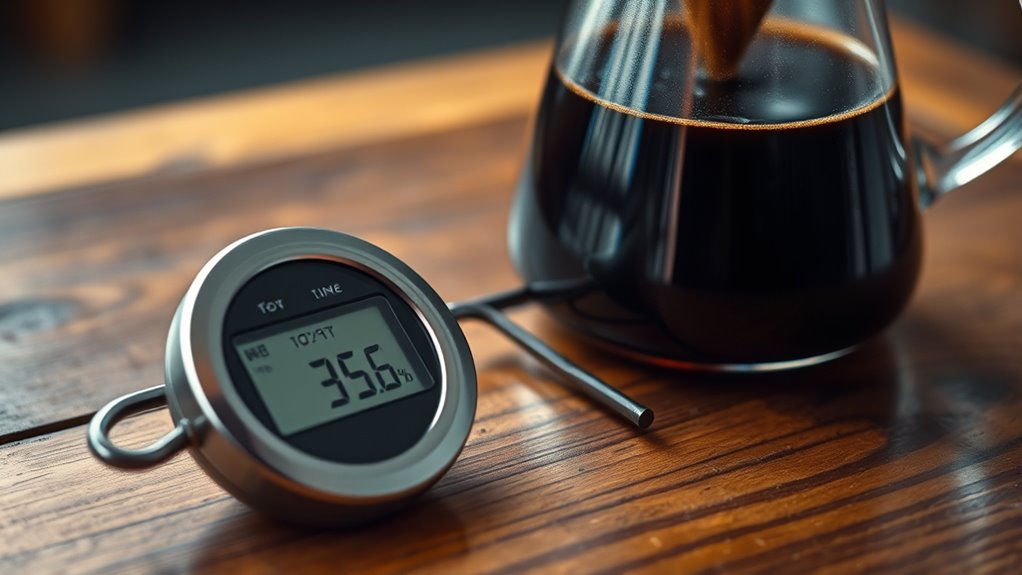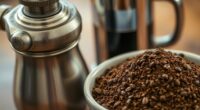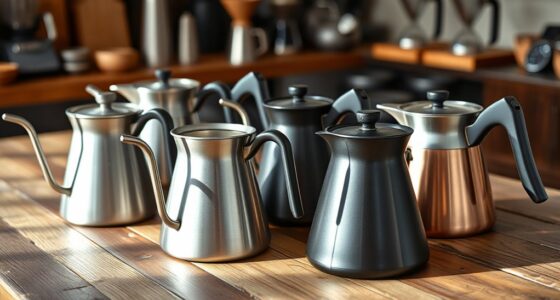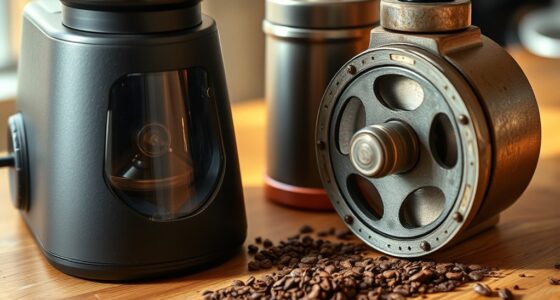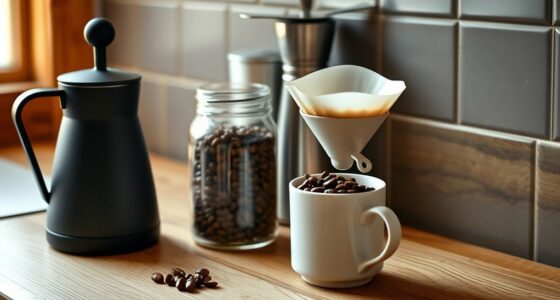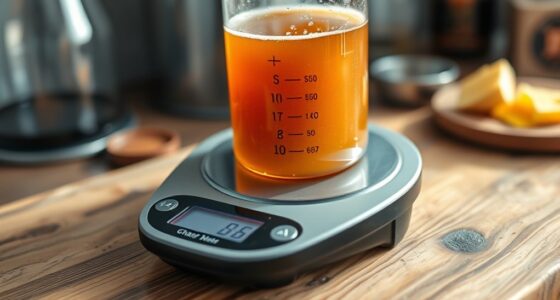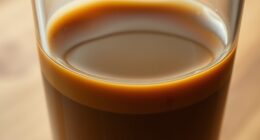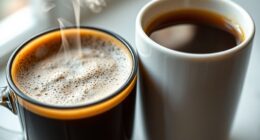Using a brewing thermometer can seriously improve your coffee. It helps you control water temperature precisely, which is key for consistent, balanced flavor. Hotter water can cause bitterness, while cooler water might lead to sourness or flatness. With a thermometer, you can adjust quickly and perfect your brewing process every time. If you want to discover better flavor and consistency, keep exploring how a thermometer can elevate your coffee game.
Key Takeaways
- A brewing thermometer ensures precise water temperature control, crucial for optimal extraction and flavor.
- It helps maintain consistency across batches, reducing guesswork and variability in coffee quality.
- Using a thermometer allows quick adjustments during brewing for better flavor and aroma outcomes.
- Regular calibration of the thermometer maintains accuracy, enhancing long-term brewing results.
- Whether you’re a casual enthusiast or a serious barista, a thermometer elevates your coffee quality significantly.
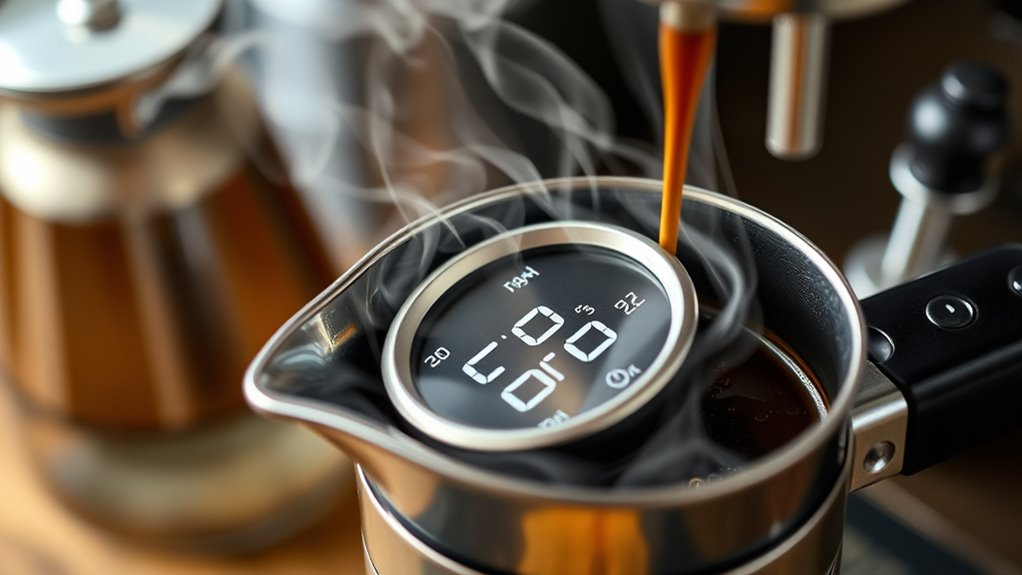
Brewing thermometers are essential tools for anyone serious about making quality beer or other brewed beverages. While they’re often associated with brewing beer, they can also play a crucial role in perfecting your coffee brewing process. When you use a thermometer, you gain precise control over temperature, which directly impacts the final product’s flavor, aroma, and overall quality. Achieving the right temperature isn’t just about hitting a number; it’s about ensuring temperature accuracy so that every batch you produce maintains brewing consistency. Without a thermometer, you’re relying on guesswork, which can lead to inconsistent results and a less than ideal cup every time.
In coffee brewing, temperature accuracy is vital because water temperature influences extraction. If the water’s too hot or too cold, you risk over-extracting or under-extracting your coffee grounds, leading to bitter, sour, or flat flavors. By investing in a good brewing thermometer, you can dial in the exact temperature needed for your preferred brewing method—whether it’s pour-over, French press, or AeroPress. This precision allows you to repeat successful brews reliably and fine-tune your process to bring out the best qualities in your beans.
Maintaining brewing consistency becomes easier when you rely on a thermometer. Consistency is key to improving your coffee skills, and a thermometer ensures that every cup is made to the same high standard. Instead of eyeballing water temperature or guessing, you can monitor and adjust your process based on accurate readings. This not only helps in achieving a balanced flavor profile but also minimizes waste and frustration. Over time, you’ll notice that your ability to produce a great cup improves because you’re controlling one of the most critical variables in coffee brewing.
Using a thermometer is straightforward, and many models are designed for quick readings, so you won’t waste time during your brewing routine. Simply insert the probe into your water or brewing equipment, wait a few seconds, and check the temperature. With this information, you can make immediate adjustments—adding hot water if it’s too cold or letting it cool slightly if it’s too hot. The more consistent your brewing temperature, the more you’ll understand how different variables affect your coffee, leading to a more refined palate and better results each time. Paying attention to the temperature calibration of your thermometer ensures that your readings remain accurate over time, which is essential for maintaining brewing precision.
Additionally, understanding the importance of contrast ratio in projectors can help you select equipment that enhances your visual experience, whether for coffee brewing tutorials or other visual presentations. In short, a brewing thermometer isn’t just a helpful accessory; it’s an essential tool for anyone who takes their coffee seriously. It ensures temperature accuracy, which is crucial for extracting the best flavors, and helps you develop brewing consistency that turns good coffee into great coffee. Whether you’re a casual enthusiast or a dedicated home barista, investing in a quality thermometer will elevate your brewing game and guarantee a better cup every time.
Frequently Asked Questions
Can I Use a Meat Thermometer for Coffee Brewing?
You can technically use a meat thermometer for coffee brewing, but it’s not ideal. Meat thermometers are designed for higher temperatures and may not accurately measure coffee temperature, which should be around 195-205°F. Using a meat thermometer might give you an approximate idea, but for precise coffee temperature control, a thermometer made for liquids is better. This helps guarantee your coffee’s flavors develop perfectly without over or under-extraction.
Are Digital Thermometers More Accurate Than Analog Ones?
When comparing digital accuracy to analog reliability, digital thermometers often lead with precise readings, quick responses, and easy-to-read displays. You benefit from consistent measurements, reducing guesswork, while analog thermometers rely on mechanical parts that can drift or become less reliable over time. If you want accuracy, speed, and ease, go digital. But if you prefer simplicity and durability, analog thermometers still offer dependable performance.
How Often Should I Calibrate My Brewing Thermometer?
You should calibrate your thermometer at least once a year to ensure accuracy. If you notice inconsistent readings or if it’s been dropped or exposed to extreme temperatures, recalibrate more often. Regular calibration maintains your thermometer’s accuracy, which is essential for brewing perfect coffee. By staying on top of calibration frequency, you’ll trust your thermometer’s readings and consistently achieve the ideal brew temperature every time.
Is a Brewing Thermometer Necessary for Cold Brew Coffee?
Back in the day, folks managed fine without fancy gadgets, but today, a brewing thermometer can be your secret weapon. For cold brew, temperature control isn’t as critical as with hot coffee, but it still matters for consistency and safety. While you don’t *need* one, using a thermometer helps you monitor your cold brew’s temperature, ensuring it’s brewed perfectly and safely. So, it’s a handy tool, but not essential.
What Is the Optimal Temperature Range for Different Coffee Beans?
To optimize your coffee, aim for an ideal temperature range of 195-205°F, which varies slightly based on bean freshness and grind size. Fresher beans and finer grinds might need slightly lower temperatures to prevent over-extraction, while older beans or coarser grinds may benefit from higher temps. Adjusting within this range helps bring out flavor nuances, ensuring you enjoy a balanced, flavorful cup every time.
Conclusion
A brewing thermometer is like a trusty compass guiding you to the perfect cup. While not always essential, it helps you hit that sweet spot of temperature for ideal flavor. Think of it as the secret ingredient that turns good coffee into great. So, if you’re serious about brewing, investing in one could make your mornings smoother and your coffee even more delightful. After all, a little precision can transform your brew from ordinary to extraordinary.
